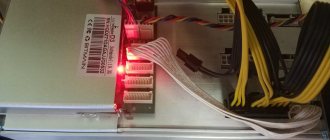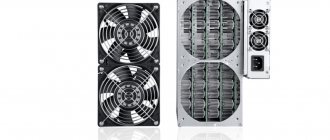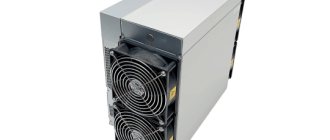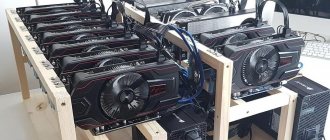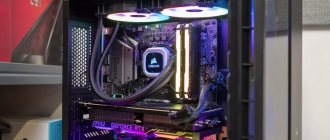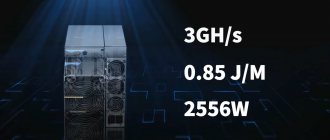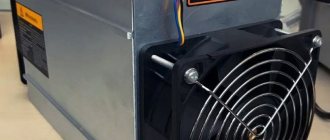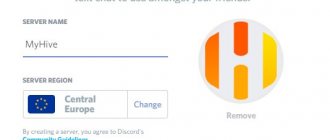In the summer of 2022, the manufacturer of equipment for cryptocurrency mining, Bitmain, announced the ASIC Bitmain Antminer D3. This was the company's first development running on the X11 algorithm. Before this, Bitmain specialized exclusively in ASICs for SHA-256 and Scrypt.
Today, the number of coins that use the X11 algorithm exceeds 100. The most famous of them is DASH (Dash), less well-known are CannabisCoin (CANN), PACcoin (PAC), Pura (PURA), etc.
Note that immediately after its release, the Antminer D3 model received enormous interest from miners, and therefore the price per unit soared to $3,000, while on the official supplier’s website its cost was $1,450.
Antminer D3 can easily be called a breakthrough in the field of coin mining using the X11 algorithm. Therefore, we decided to analyze this design in more detail and clarify the reason for the excitement.
- What does Asic Bitmain Antminer D3 look like?
- Characteristics of Antminer D3 and differences from Antminer D5
- Profitability of Antminer D3
- Where to buy Antminer D3
- Installing Asic Antminer D3 Setting up Antminer D3
- Overclocking Antminer D3 and firmware
Technical characteristics of Antminer D3
Externally, the D3 is no different from its predecessors: the same rectangular metal body, fairly compact dimensions (130 x 320 x 190 mm) and low weight (5.5 kg). Area of use: mining cryptocurrencies running on the X11 algorithm: dash, pura, boolberry, monetaryunit and some lesser known ones.
ASIC D3 is suitable for mining DASH and other popular crypto coins
The device has three boards, each of which is equipped with 60 chips and three connectors for connecting a power supply. There is an additional connector on the control board. To connect the miner, you need a power supply with 10 PCI-E connectors, which is purchased separately. Since the performance of ASIC D3 is impressive - 15 gigahash/sec., an appropriate power supply is required.
Please note: the power supply is not included in the basic package, so you will have to shell out an additional $150. Bitmain Corporation recommends its APW3 block. But you won’t have to pay extra for the controller, as is the case with Avalon, since it is already built into the unit.
The energy consumption level of Antminer D3 is 1,200 W. For cooling, two S9 fans are used, which uniformly blow the radiator blades. The noise level during operation is 90 dB. If you set the fans to 3,500 prm, the noise will drop to 70 dB.
It is recommended that the device have a power reserve 20-30% higher than that required for stable operation. The most popular model in this series is considered to be the “Bitmain” APW++ with a power of 1,600 W.
Payback
Interest in antminer d3, which mines Dash, is well justified by its good payback. This cryptocurrency has a rapid growth trend. Now it costs about 280 dollars, and in the middle of the year its price did not even reach 200. Considering that not so long ago one coin could be bought for a hundred, then the growth trends are obvious. Jumps up or down are present, but they are short-lived. There was no long-term fall in the exchange rate. Upon general consideration and assessment, Dash can be called a quite promising cryptocurrency.
So, is it worth buying an ASIC and what kind of profit can you expect?
If we take the cost of electricity as a basis of 9 cents per kilowatt per hour, then for a month of operation of the ASIC you can count on a profit of $4,500. Theoretically, it can pay for itself within this period and bring a good profit. But this is theoretical. In practice, things are a little different.
First of all, you need to take into account the constantly increasing complexity of the network; accordingly, the level of cryptocurrency production will not be able to remain at the same level. This trend is facilitated by the active distribution of miners for Dash, so a decrease in profitability can be predicted.
Of course, you can pay attention to other cryptocurrencies that can be mined on antminer d3, but none of them have shown such stable growth recently, so it’s too early to talk about their prospects.
What can you get as a result? It’s no longer worth counting on payback in a month, especially now. The main peak in sales of ASICs occurred in the fall and by now a large number of devices are already successfully mining cryptocurrency. There is no decline in sales and the number of Dash miners is constantly increasing. This contributes to the emergence of an active tendency to complicate the network and reduces profitability, which will steadily decrease every day.
Now you can count on payback in 3 or even 4 months, this is quite realistic. But in the future the period will become much longer. From August 1 to September 1, the complexity actually increased 2 times, and from September 1 to October 1 - already 5 times, and the trend continues to persist. Therefore, it is difficult to predict what the miner’s payback will be by the beginning of the new year. If the Dash rate grows steadily, then at least you can count on it, even taking into account how much antminer d3 mines now.
Settings
Connecting and setting up Antminer D3 is as easy as any other ASIC from Bitmain: the same set of functions, familiar control panels. It is enough to perform a few simple manipulations:
- connect the power supply to the miner (plug the connectors into the connectors until they click);
- plug the power supply into the outlet;
- connect the antminer to the router;
- determine the IP address of the device.
One of the simplest ways to determine the address is to use the router's start page. To do this, you need to open any of the available browsers and enter 192. 168. 0. 1 or 192. 168. 1. 1 in the search bar, as well as the login/password pair. By default, the login is admin, the password is 1234, 1111 or admin (if the settings have not been changed). After this, all you have to do is find the name of your miner and its IP in the list that opens.
Next, you can choose a mining method and configure your equipment for solo mining or connect to one of the pools, which is much more profitable. Note that in addition to Antpool’s own Bitmain mining pool, Antminer D3 can work with other sites. We list the most profitable and reliable of them:
- Nicehash;
- Prohashing;
- ZPool;
- P2Pool.
During independent testing of this model on different pools, the performance turned out to be approximately the same: 16.2 GHz/sec. with a power consumption of 1185 W. At a room temperature of +20 degrees, the rotation speed of the coolers was 3,200 rpm, and the noise level was 74 dB. As the temperature increased, the speed and noise also increased.
Profitability and payback period of Antminer D3
In August 2022, when the new ASIC first went on sale, the dash rate grew steadily and reached $300 by the end of the month. With an electricity tariff in Moscow of $0.09, the profitability calculator showed average monthly profit values of about $4.5 thousand. This means that the equipment at that time paid for itself in less than a month. Of course, this situation did not last long. As soon as the market was filled with a large number of D3, the complexity of the network increased and production dropped significantly.
As of the time of writing this article (09/16/2018), the dash rate, according to Coinmania, is $194. So far, the decline continues, but, according to expert forecasts, in the coming months the cryptocurrency market should partially regain lost ground, and then mining income will also increase. Today, the average payback period for ASIC D3 is more than 2.5 years.
Dash rate for September 2022 according to Coinmania
It is no longer possible to buy the Bitmain D3 model on the manufacturer’s official website, but they are still presented in the catalogs of Russian online stores. The price of the model with a hashrate of 19.3 GHz/sec. is about 100 thousand rubles.
To understand how profitable an investment in D3 can be right now, we suggest you use the online profitability calculator on nicehash.com. After you enter the name of the miner, the cost of electricity in your region and other necessary data, the service will calculate the approximate daily profit and payback period.
Where to buy Antminer D3
Purchasing miners
Let us note that owners of equipment purchased for thousands of dollars received losses and disappointment. Bitmain tried to compensate for the damage by issuing coupons that gave owners a discount of a certain amount when purchasing products on its website. As a result, the price of Antminer D3 has dropped tenfold and now the device can be purchased for less than $100.
☝️
Unfortunately, due to the fiasco and lack of demand for the device, Bitmain discontinued this model back in November 2022. In this regard, it will not be possible to buy it on the manufacturer’s official website, but Antminer D3 can still be found in the warehouses of online stores that previously purchased products for resale.
It will not be easy for residents of Ukraine to purchase this model
. Many stores have long sold out of this product and updated their assortment. Today, Antminer D3 is available for purchase on the Rozetka online store at a price of 10,000 UAH ($400) and on ad sites, for example, OLX for 5,000 UAH ($200).
In the second case, you need to be especially careful, since the transaction will most likely be concluded with an individual without providing any guarantees.
As for the Russian segment, this device can be purchased on the antminer-russia website for 8,850 rubles ($150), or you can place an order with a manager for 40,000 rubles (about $750). As you can see, despite the meager selection, the price range of products is very wide.
You can also look for second-hand products on thematic platforms, Telegram channels and forums. However, such transactions are characterized by a high level of risk, so the main thing is not to let down your guard.
History of the creation of Antminer D3
At the beginning of the development of the cryptocurrency industry, the attention of the vast majority of miners was focused on the extraction of military-technical exchange. Interest in other cryptocurrencies - promising and less expensive - arose gradually as the Bitcoin network became more complex. With the advent of Antminers L3 and L3+, many switched to litecoin, and a little later - to dash.
The X11 algorithm that dash runs on is a complex combination of 11 hash functions, but requires much less computational energy than SHA-256 and Scrypt.
Note that the creators of the new coin have made every effort to exclude the possibility of its mining using ASICs. But the plans of cryptocurrency developers, as a rule, do not coincide with the plans of mining equipment manufacturers. Especially if an industry monster like Bitmain comes into play. And when it comes to big money.
Taking into account the increasing popularity of dash, the Chinese corporation decided to develop a special device for the X11 algorithm. And soon a new ASIC called Antminer D3 went on sale.
High demand for the first and second batch of new equipment provoked an increase in its cost: the initial price of $1,450 soon rose to $2 thousand and more. But there were no fewer people wanting to buy D3. Of course, the excitement was fueled by the rapid rise of the cryptocurrency market, which just happened in the second half of 2022.
Features of the algorithm, the rise and fall of mining on it
If at first ASICs were made only for Bitcoin mining and were suitable for cryptocurrencies based on the SHA-256 algorithm, then, with the growing complexity of the Bitcoin network, manufacturers began to add devices to their line that work with the Scrypt and X11 algorithms. Today we will take a closer look at the latter, on which the Dash cryptocurrency operates. There is a separate article about its mining - “Mining DigitalCash”.
X11 is notable for the fact that it uses 11 hashing functions at once. Its mining is not as energy-intensive as when working with SHA-256 and Scrypt. This algorithm was created so that ASICs could not mine cryptocurrencies based on it - but in the end, the obstacles turned out to be insufficient, and such ASICs appeared on the market.
The owners of the first devices hit a truly big jackpot: they brought in up to $200 a day, paying for their purchase in a couple of weeks. However, the complexity of the network began to grow very quickly, and the efficiency of each individual ASIC began to decrease accordingly. At some point, the market turned out to be oversaturated and mining on ASIC X11 began to barely pay for electricity. In recent months, however, a gradual increase in its profitability has again been observed - this is mainly due to the rise in the price of coins, and the fact that the complexity of their network is practically not growing, because new miners prefer to buy devices to work with more profitable algorithms.
Advantages and disadvantages of ASIC miner D3
The key advantages of Antminer D3 include the famous name of its manufacturer. The equipment that came off the assembly line of the Chinese corporation Bitmain has repeatedly received high praise and rave reviews from both ordinary users and experts.
The D3 miner is easy to use, has high performance, and provides a good income. In addition, it is designed for mining dash, a coin that is one of the most promising for mining today.
The cost of the D3 is more affordable compared to other models of specialized mining equipment, which is also very important. Of course, we are talking about comparative affordability, since ASICs initially belong to the category of devices that not everyone can afford.
As for the disadvantages, they are the same for any mining equipment: rapid loss of relevance, long payback period. From the summer until the beginning of 2022, this model remained one of the most productive for mining coins running on the X11 algorithm.
For some time, its main competitor remained the Miner DR-100 produced by Pinidea. A few months ago, the developers increased the hashrate of the DR-100 to 22 GHz, after which Antminer began to yield. And soon a new player was released onto the market - Innosilicon A5 DashMaster, capable of delivering 32.5 GHz with an electricity consumption of 750 Wh, and this became a significant claim to success.
Miner capabilities
Immediately at the time of the release of this model, it was the most profitable of the ASICs and paid for itself in just a few weeks, which made it a real hit. Now, however, its capabilities no longer look so great: the power of cryptocurrency networks based on the X11 algorithm has increased significantly, primarily due to the D3s themselves, which were sold out too much. And coin prices have fallen significantly since the beginning of the year, which also contributed to the decline in profitability.
Don't forget about your competitors. If the D3 was once the most powerful X11 miner, this title has now been lost: the Pinidea Miner DR-100 Pro has a hashrate of 22 GH per second, as does the iBelink DM-22G. Innosilicon has even rolled out the A5 Dashmaster, which combines a power of 32.5 GH per second with an energy consumption of 750 W per hour - much more efficient than the D3. Under these conditions, D3 was saved by the price reduction. Even though it can't compete in terms of power, the ASIC's low cost still makes it an interesting choice.
To increase power, experienced miners often use an option such as overclocking. Moreover, the D3 comes with software with which you can adjust the frequency of the chips. But in terms of overclocking capabilities, the D3 does not have high potential: increasing the frequency to more than 590 MHz is undesirable.
Comparison of Antminer D3 with other ASICs for dash
For some time, the main competitor of the D3 remained the Miner DR-100 produced by Pinidea - a reliable and compact unit with a productivity of 19 gh\sec and an energy consumption of 0.9 kW. A few months ago, the developers increased the hashrate of the DR-100 to 22 GHz, after which Antminer began to be noticeably inferior to it.
And soon a new player was released onto the market - Innosilicon A5 DashMaster, capable of delivering 32.5 GHz/sec. (overclocking to 38 GHz/sec is possible) with a consumption of 750 Wh/h, and this has become a significant claim to success. Especially considering the fairly affordable price for such power - $2.7 thousand and a six-month manufacturer's warranty.
Another competitor of Antminer D3 is iBeLink DM22G X11 Dash Miner - an ASIC released in 2022 with a performance of 22 gh\sec and consumption of 0.81 kW of electricity, which does not lose its relevance this year. Its distinctive features are the presence of self-diagnosis and subsequent recovery functions, transmission of information by e-mail, and extreme ease of operation. To get started, just plug in the power cable and Erhernet into the network. The system is cooled by 5 fans, which completely eliminates overheating.
Comparison table of D3 and competitors

